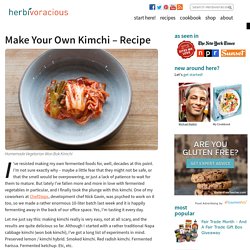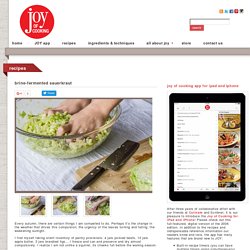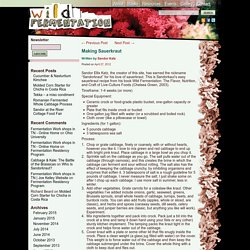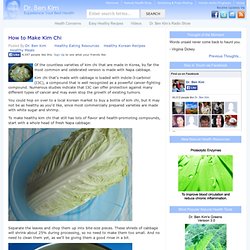

Making Your Own Kimchi. Homemade Vegetarian Won Bok Kimchi I‘ve resisted making my own fermented foods for, well, decades at this point.

I’m not sure exactly why – maybe a little fear that they might not be safe, or that the smell would be overpowering, or just a lack of patience to wait for them to mature. But lately I’ve fallen more and more in love with fermented vegetables in particular, and I finally took the plunge with this kimchi. One of my coworkers at ChefSteps, development chef Nick Gavin, was psyched to work on it too, so we made a rather enormous 10-liter batch last week and it is happily fermenting away in the back of our office space. Yes, I’m tasting it every day. Let me just say this: making kimchi really is very easy, not at all scary, and the results are quite delicious so far.
Nick and I came up with our recipe for this first batch by watching a bunch of videos and reading recipes all over the web, and then combining what seemed to us like the best ideas, ratios, and methods. Hot and Healthy: How to Make Better Kimchi at Home. Photo by Perry Santanachote Kimchi (also spelled “kimchee”) is a traditional Korean dish that uses the process of fermentation to pickle and preserve fresh vegetables.

The spicy, crunchy, cabbage-based vegetable mixture has a texture similar to sauerkraut but boasts much bolder flavors thanks to garlic and spicy seasonings. Originally developed in 7th Century Korea as a means of storing vegetables during cold winters, the dish has been steadily — if slowly — gaining recognition beyond the boundaries of its native country.
While Chinese, Japanese, and Thai cuisine have long been popular in the U.S., it’s taken Korean food significantly longer to work its way into American mouths. But its Asian-food forbearers helped popularize spicy flavor profiles (think rooster-red Sriracha), which no doubt paved the way for Korean food’s entrée into American markets. Recipe: DIY Kimchi. Brine-Fermented Sauerkraut. Every autumn, there are certain things I am compelled to do.

Perhaps it’s the change in the weather that drives this compulsion; the urgency of the leaves turning and falling; the weakening sunlight. I find myself taking silent inventory of pantry provisions: 4 jars pickled beets, 10 jars apple butter, 3 jars brandied figs… I freeze and can and preserve and dry almost compulsively. I realize I am not unlike a squirrel, its cheeks full before the waning season. Apple butter is one of my yearly preserving pursuits. I typically make several batches of the stuff through some feat of nesting fever. But again, it’s an urge strong enough to make me not mind the inevitable burns I will get on my forearms while attempting to stir the lava lake of molten apple pulp.
Make Your Own Sauerkraut - B2087.pdf. ADDITIVES - make sauerkraut.pdf. Sauerkraut fermentation. Sauerkraut fermentation requires almost no work on the part of the operator.

Cabbage contains enough lactic acid bacteria in order to ferment and produce sauerkraut with salt alone. In order to obtain product of the highest quality all those bacteria strains must ferment in a certain sequence. This happens naturally as long as sauerkraut is fermented around 65° F (18° C). Leuconostoc mesenteroides - they are the smallest and start the fermentation first producing around 0.25 to 0.3% lactic acid. They are heterofermenters, this means that they produce different compounds such as lactic acid, acetic acid (vinegar), ethyl alcohol, carbon dioxide (soda gas) and mannitol. Sauerkraut fermentation. Any change to the above cycles of lactic acid production will alter the taste and quality of sauerkraut.
Effect of Fermentation Temperature The best quality sauerkraut is produced at 65-72° F (18-22° C) temperatures. Below 45.5° F (7.5° C) fermentation time is up to 6 months. Bacteria Control Washing. Untitled. View topic - Harsch crocks vs. cooking crockpots? I have found what I consider a fool-proof vessel for fermentation, meaning no molds or yeast to contend with, ever again, at least for myself so far.

With crocks I have had hit and miss success. I have been using the "Pickl-It", found here.... Lactic Acid Bacteria (LAB) thrives in an Anaerobic (without oxygen) environment as well as total darkness. The jars are made in Italy and the only ones that I am aware of that do not contain minerals such as lead, cadmium or aluminum in either the hardware or glass components. It is my understanding that even Crockpot crocks are laced with cadmium. The airlock system on the top is a typical wine makers airlock. Some people tell me to place a brine or water filled bag over the top of the crock to keep oxygen out.
Making Sauerkraut. Sandor Ellix Katz, the creator of this site, has earned the nickname “Sandorkraut” for his love of sauerkraut.

This is Sandorkaut’s easy sauerkraut recipe from his book Wild Fermentation: The Flavor, Nutrition, and Craft of Live-Culture Foods (Chelsea Green, 2003). Timeframe: 1-4 weeks (or more) Special Equipment: How to Make Kim Chi. Of the countless varieties of kim chi that are made in Korea, by far the most common and celebrated version is made with Napa cabbage.

Kim chi that's made with cabbage is loaded with indole-3-carbinol (I3C), a compound that is well recognized as a powerful cancer-fighting compound. Numerous studies indicate that I3C can offer protection against many different types of cancer and may even stop the growth of existing tumors. You could hop on over to a local Korean market to buy a bottle of kim chi, but it may not be as healthy as you'd like, since most commercially prepared varieties are made with white sugar and shrimp.
To make healthy kim chi that still has lots of flavor and health-promoting compounds, start with a whole head of fresh Napa cabbage: Separate the leaves and chop them up into bite-size pieces.